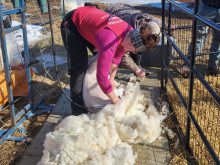It may seem obvious, but it’s a message that’s worth repeating: close monitoring of bulls can help cattle producers maximize profits.
Producers were reminded of the steps to ensure proper nutrition and limit the spread of sexually transmitted diseases in their animals at a session on bull nutrition, fertility and herd management hosted by the Farm Animal Council of Saskatchewan on Dec. 7 ahead of the organization’s annual conference in Saskatoon.
Managing these factors can minimize reproductive failures, the primary reason for culling an animal.
Read Also

Charges laid after cattle theft
Saskatchewan RCMP lay two charges against a man after six cattle went missing.
“There’s as many ways to feed and develop young bulls as there are producers,” Bart Lardner, a senior research scientist at the Western Beef Development Centre, told the group.
When it comes to raising healthy and fertile bulls, nutrition is paramount, he said.
Whether it’s a yearling or a mature bull, producers should watch what they’re putting in front of the animal. While the quantity of hay and forages may be there, the quality could be lacking, he explained. A nutrient-deficient diet will result in a bull losing condition and performing poorly during the breeding season.
“Don’t be afraid to work with a nutritionist to ensure that you’ve feed tested all of your sources and built a program that’s going to work for you,” said Lardner.
It’s an added expense, but a worthwhile investment, he said. By carefully managing nutrient, energy and mineral intake, producers can achieve optimal performances from their animals.
Water, said Lardner, is an overlooked nutrient. Depending on the source, there can be concerns from sulfates and salt. Producers should have their water tested.
Likewise, vitamins, including E and D, can be overlooked.
“Where do they come from? Green leafy materials,” said Lardner. “Do we find green, leafy materials in a winter feeding program? No, not generally, so probably a booster shot in that fall time period going into that winter feeding program is essential.”
For the first year of their lives after weaning, bulls are usually fed to gain upward of three pounds every day. At the start of the first breeding season, bulls should have a body conditioning score of 3.5, he said (with one being emaciated and five obese).
Lardner also warned of over conditioning bulls, which can decrease activity during the breeding season.
“They just can’t take it in those hot months of the summer,” said Lardner. “They’ll have to lose a little bit of that condition until they get to a situation where they’re able to perform and by then most of the breeding season is done.”
Bulls should weigh 75 to 80 percent of their mature body weight at the start of the second breeding season.
“Don’t wait until it’s too late,” said Lardner. “Look at their condition coming into the fall off that first breeding season and probably start to provide some supplementation program over that second winter.”
Sexually transmitted diseases can impede growth and affect a producer’s bottom line, said Cheryl Waldner, a professor at Saskatoon’s Western College of Veterinary Medicine.
She highlighted bovine viral diarrhea virus, trichomoniasis and vibrio as diseases producers should watch for. BVDV is present in as many as nine percent of herds in Saskatchewan and Alberta, she said.
Whether an animal is persistently or acutely infected, it can pass BVDV on while breeding
“The problem with this particular virus is sometimes it’ll go hide in the testicles,” she explained. “And then it can go share and care with the cows when he’s out in the pasture.”
Waldner said producers should have a control and biosecurity plan to prevent the entry and spread of sexually transmitted diseases.
















